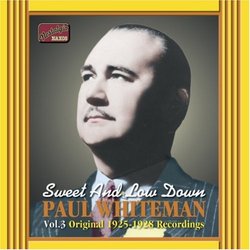| All Artists: Paul Whiteman Title: Sweet & Low Down Members Wishing: 0 Total Copies: 0 Label: Naxos Original Release Date: 1/1/2025 Re-Release Date: 11/26/2002 Genres: Jazz, Pop Style: Swing Jazz Number of Discs: 1 SwapaCD Credits: 1 UPC: 636943262825 |
Search - Paul Whiteman :: Sweet & Low Down
CD Details |
CD ReviewsEarly Whiteman at his best! Steven Phillips | Ada, OK United States | 01/05/2005 (5 out of 5 stars) "Paul Whiteman's once-stellar reputation has been sullied in recent years and his many contributions to popular music have been largely ignored or deprecated. This is truly unfortunate. Whiteman's legacy includes the melding of classical musical forms with the jazz idiom; making jazz a respectible musical form; promoting dance music of the highest quality; presenting experimental works by little-known American composers; and elevating virtuoso "jazz" musicians to star-status. Whiteman - and his arranger, Ferde Grofe - united a number of disparate musical trends in existence before 1920 and combined them into a form that can be characterized as the age of large dance orchestras of the 1920s-1940s. The Whiteman paradigm of playing music in strict tempos with vocal refrains as being merely incidental began to be replaced with swing after 1936, and was totally obsoleted by the time bop became popular after the second world war. However, if you attend a Broadway musical today, the musical style you hear will have strong connections to the earlier efforts of both Whiteman and Grofe. Whiteman has become a pariah to modern music critics because of his claim to the title of "The King of Jazz". While his orchestra contained many of the finest jazz musicians of the day - Beiderbecke, Trumbauer, the Teagardens, the Dorseys, Venuti, Lange, Brown, etc. - the jazz output, per se, was very limited. Critics felt that Whiteman's claim to the crown in light of the jazz contributions of Oliver, Armstrong, Morton, Henderson, Redman, Ellington, Moten, Goldkette, etc. bordered upon the worst kind of arrogance. For this faux pas he was to never be forgiven nor accorded respect for his many tangible contributions. I feel that if he had moderated critical hostility by referring to himself as "King of Symphonic Jazz", Whiteman would today hold a much deserved, dignified place in the pantheon of jazz greats. This CD covers the largely neglected, faux-jazz period in Whiteman's output running from the beginning of electrical recordings in 1925 and continuing into 1928 when his orchestra became greatly enlarged. Most of the tracks on this CD are played by Grofe's "perfect orchestra", which has four instrumental voices in each section, allowing the sections to end a phrase with a sixth chord [Whiteman and McBride. (1926). Jazz.] The instrumentation is largely two trumpets, two trombones, four reeds doubling on many instruments, two violins (enlarged to four in 1927), piano, banjo, tuba, and drums. This orchestral combination has played some of the finest dance music ever recorded. The songs are generally of a lighter vein and contain some breath-taking performances by Ross Gorman and Charles Strickfadden on reeds, electrifying trombone solos by Wilbur Hall (who played on segments of the Gong Show on television in the early 1980s), and the fantastic trumpet-work of Henry Busse. This is the type of music that made Whiteman a household name in the 1920s, and is some of the best representative, "symphonic jazz" music of that period. This NAXOS CD has presented these early electrical recordings in a very enjoyable package. If you like music from the 1920s but have only heard the Whiteman recordings from the Beiderbecke period of 1927-1929, you will find here an entirely different dimension of well-written, well-scored, happy, and bouncy music played by the absolutely highest-caliber musicians that ever graced a dance orchestra." Electric shocks. John Austin | Kangaroo Ground, Australia | 09/13/2003 (5 out of 5 stars) "Great excitement must have greeted the advent of the electric recording process in 1925. Heard on this Naxos issue are surely some of the very earliest examples, recorded in Camden, New Jersey, 6th May 1925. The arrangements and the instrumentation probably are not much different from those used for earlier recording sessions that year, using the acoustic process, but Whiteman's musicians and the record-buying public must have been excited by the results. Original pressings must have received a bashing, one way or another, and it seems miraculous that we are able today to hear the recordings in pristine sound. Whiteman's significance, it has been claimed, was his capacity for attracting talented musicians rather than evincing any special musical qualities of his own. He nevertheless put his stamp on all recordings he supervised. There is always a kind of relentless bounce in the rhythm. Indeed, the Whiteman rhythm seems to convert such dissimilar items as Padilla's "Valencia" and Rodgers' "Manhattan", heard of this CD, into identical twins." Sweetly lowdown Whiteman classics Lee Hartsfeld | Central Ohio, United States | 11/28/2002 (5 out of 5 stars) "Fabulous Paul Whiteman collection that focuses mostly on the period between "Rhapsody in Blue" and the arrival of Bix Beiderbecke. The hotter numbers in the track list (Charleston, Me Too, the title number, etc.) effectively fly in the face of some of the long-standing myths about Whiteman's orchestra-for example, that the band never played jazz prior to the arrival of Bill Challis and other displaced Jean Goldkette bandmembers, or that it never played jazz at all, or that chief Whiteman arranger Ferde Grofe's work was the antithesis of, say, Don Redman's for Fletcher Henderson. Nonsense-and the proof is here. Most of these tracks are Grofe concoctions, and, even when they stray from jazz style, they are nothing less than stunning examples of Jazz Age orchestration. Phenomenal playing, fun novelty numbers (like "Ogo Pogo," featuring Billy Murray, which has to be heard to be believed), and very good sound restoration by NAXOS. The liner essay is awful, but one can't have everything. It's the music that matters."
|

